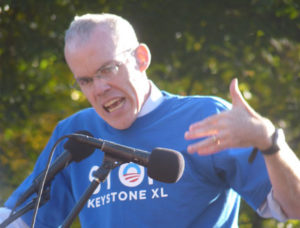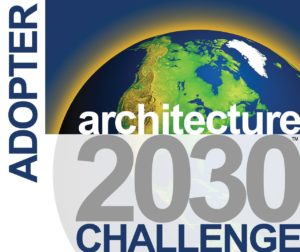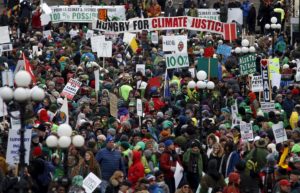“I’m not a believer in man-made global warming.” –Donald Trump, President-elect

This quote comes from a recorded interview Hugh Hewitt had with Mr. Trump on September 21, 2015. (No Pinocchios!) And, there have been other interviews to the same effect. Mr. Trump has pledged to cancel U.S. participation in the Paris Climate Accord which ratification date was 11/4/16.

 Meanwhile, U.S. Sec. of State John Kerry recently visited Antarctica and McMurdo Station to see first-hand the effects of global warming. As reported by AP, he said: “We need to get more of a movement going. We need to get more people to engage.”
Meanwhile, U.S. Sec. of State John Kerry recently visited Antarctica and McMurdo Station to see first-hand the effects of global warming. As reported by AP, he said: “We need to get more of a movement going. We need to get more people to engage.”
Kerry planned to use his experience in Antarctica to under-gird his address on the dangers of climate change at the Paris Accord follow-up conference this week in Marrakesh, Morocco. The meeting’s agenda is centered on how to implement the Accord. It’s being reported that leaders from 200 countries are in attendance.
Here are other sentiments…
Bill McKibben: The journalist/author and 350.org co-founder said the other day of Trump’s election to be the 45th U.S. President: “It’s clear that [Trump] wants no part of environmental progress, and I imagine the damage from this election will be measured in geologic time.”
 In an interview with Nermeen Shaikh of “Democracy Now,” Shaikh asks: “Bill, you’ve also said that the damage from this election will be measured in geologic time.”
In an interview with Nermeen Shaikh of “Democracy Now,” Shaikh asks: “Bill, you’ve also said that the damage from this election will be measured in geologic time.”
“That’s right,” McKibben says. “The Trump presidency comes at a moment when we could least afford it. It’s not like we were winning the climate battle before… There was beginning to be the kind of ramp-up… The world managed a year ago at Paris to do something, anyway, for the first time, about climate change. Now we’re going to hit not a pothole, but a ditch in the road.
“Physics is our enemy, and it imposes a difficult time limit here. We don’t have any more presidential terms to waste. So we’re going to have to figure out, as a nation and, maybe more importantly, as a planet, how to work around Trump, to one degree or another.”
Andrew Jones, Climate Interactive: What would some of the effect of a U.S. withdrawal from the Accord amount to? Jones, co-director of Washington, D.C.-based think tank, “Climate Interactive,” told Chris Mooney of The Washington Post: “Climate Interactive’s analysis finds that the U.S. pledge amounts to the avoidance of 22 gigatons, or billion tons, of carbon dioxide equivalent emissions between the years 2016 and 2030.
“But all of the pledges, by all of the countries, only amount to the avoidance of a little over 100 gigatons. Thus, the U.S.accounts for around 20 percent of the total, which is not surprising, given the size of the country and the fact that it is the world’s second largest emitter after China.”
 Edward Mazria, Founder and CEO, Architecture 2030: 2 days ago, Architecture2030 ENews reported climate initiatives and results offered by Mazria: “Worldwide, 533 cities are now reporting their greenhouse gas (GHG) emissions, a 70% increase in reporting since the Paris Agreement. To date, 30% of these cities have GHG emissions reduction targets. In North America, 56% of the cities reporting have GHG emissions reduction targets, many declaring zero emissions or an 80% reduction by 2050 or earlier.
Edward Mazria, Founder and CEO, Architecture 2030: 2 days ago, Architecture2030 ENews reported climate initiatives and results offered by Mazria: “Worldwide, 533 cities are now reporting their greenhouse gas (GHG) emissions, a 70% increase in reporting since the Paris Agreement. To date, 30% of these cities have GHG emissions reduction targets. In North America, 56% of the cities reporting have GHG emissions reduction targets, many declaring zero emissions or an 80% reduction by 2050 or earlier.
“The International Union of Architects with member organizations representing over 1.3 million architects in 124 countries worldwide has unanimously adopted the 2050 Imperative, a declaration to eliminate CO2 emissions in the built environment by 2050. [Separately,] over 350 firms have joined the AIA 2030 Commitment.” Note: nearly 40% of all GHG emissions are derived from buildings.
“At the utility scale, flattening electricity demand (due to building efficiency gains) in the U.S. will make the need for new fossil fuel fired power plants unlikely. Photovoltaic (PV) and wind energy production is cheaper and more feasible than ever. Residential and community solar installations and financing mechanisms are increasing dramatically, providing affordable energy and access to homeowners and renters at all income levels. There are now 300,000 solar jobs in the U.S., ” double the number 12 months ago.
“The emergence of new PV products and battery storage is likely to transform the housing market, while LED lighting has already had a huge impact in lowering energy consumption and emissions in the commercial building sector. Wind energy is growing rapidly and is another bright spot in our economy with wind jobs increasing 20% in 2015.”
Many readers of this blog support the initiatives of the Architecture2030 Challenge; and environmental stewardship.
Regardless of when the EPA powers and other federal environmental policy are seriously diminished under the Trump Administration, let’s keep pressing states, municipalities, leading U.S. corporations and non-profits to maintain their collective acceleration towards environmental wellness!


